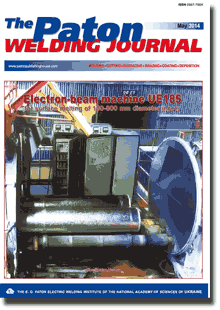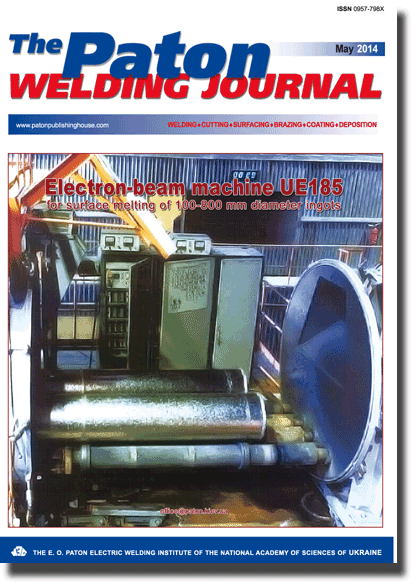| 2014 №05 (03) |
DOI of Article 10.15407/tpwj2014.05.04 |
2014 №05 (05) |

The Paton Welding Journal, 2014, #5, 21-27 pages
INCREASE OF FATIGUE RESISTANCE OF SHEET WELDED JOINTS OF ALUMINUM ALLOYS USING HIGH-FREQUENCY PEENING
V.V. KNYSH, I.N. KLOCHKOV, M.P. PASHULYA and S.I. MOTRUNICH
E.O. Paton Electric Welding Institute, NASU. 11 Bozhenko Str., 03680, Kiev, Ukraine. E-mail: office@paton.kiev.ua
Abstract
A work is dedicated to experimental investigation of dependencies of fatigue resistance of sheet (d = 2-3mm) welded joints of average and high strength aluminum alloys, which were produced using consumable-electrode pulsed-arc welding in inert gases (PMIG) as well as determination of efficiency of rise of their fatigue life through application of high-frequency mechanical peening (HFMP) by set parameters of strengthening. Efficient parameters of HFMP strengthening of sheet welded joints with the help of portable manual equipment USP-300 were determined based on measurement of microhardness, local geometry parameters of weld and angular residual lipping distortion. Influence of HFMP of zone of weld to base metal transition on measurement of stress concentration factor, welding residual stresses and structure of surface layer of butt joints of small thickness aluminum alloys was investigated. It is shown that increase of radius of weld to base metal transition and elimination of angular residual lipping distortion after HFMP treatment provides for 1.35-1.49 reduction of stress concentration factor in the joints. It is determined that life on the basis of testing 2р106cycles of stress alternation for strengthened butt joints from D16T alloy shows 5 times rise, that for AMg6 alloy makes 4 times and 7 times for 6061-T6 alloy in comparison with initial as-welded condition. The recommendations are given on efficient HFMP strengthening of sheet welded joints for increase of their fatigue life and elimination of residual welding deformations. 15 Ref., 2 Tables, 11 Figures.
Keywords: welded joint, high-cycle fatigue, aluminum alloys, fatigue life, high-frequency mechanical peening, consumable-electrode pulsed-arc welding, increase of fatigue resistance
Received: 21.01.14
Published: 28.05.14
References
1. Elagin, V.I. (2009) Structural nanoalloys alloys on aluminium base. Tsvet. Metally, 6, 103-111.
2. Filatov, Yu.A. (1996) Wrought alloys based on Al-Mg-Sc system. Metallovedenie i Term. Obrab. Metallov, 6, 33-36.
3. Fridlyander, I.N., Beletsky, V.M., Krivov, G.A. (2000) Aluminium alloys in aircraft structures. Tekhnologich. Sistemy, 1(3), 5-17.
4. Ishchenko, A.Ya., Labur, T.M., Bernadsky, V.N. et al. (2006) Aluminium and its alloys in current welded structures. Kiev: Ekotekhnologiya.
5. Ishchenko, A.Ya., Labur, T.M. (2013) Welding of current structures from aluminium alloys. Kiev: Naukova Dumka.
6. Mashin, V.S., Pavshuk, V.M., Dovbishchenko, I.V. et al. (1991) Influence of pulsed-arc welding conditions of aluminium AD0 on shape and porosity of welds. Avtomatich. Svarka, 4, 57-60.
7. Shonin, V.A., Mashin, V.S., Vojtenko, O.V. et al. (2003) Improvement of fatigue resistance of tee welded joints in sheet aluminium alloy AMg6. The Paton Welding J., 7, 7-10.
8. Ostrovsky, O.S., Gudko, A.V., Kudryashyov, O.N. et al. (1992) Consumable-electrode pulsed-arc welding of large-sized structures of aluminium alloys. Svaroshn. Proizvodstvo, 10, 7-9.
9. Lobanov, L.M., Kirian, V.I., Knysh, V.V. et al. (2006) Improvement of fatigue resistance of welded joints in metal structures by high-frequency mechanical peening (Review). The Paton Welding J., 9, 2-8.
10. Mashin, V.S., Pashulya, M.P., Shonin, V.A. et al. (2010) Consumable electrode pulsed argon-arc welding of sheet aluminium alloys. Ibid., 5, 38-41.
11. Trufyakov, V.I. (1990) Strength of welded joints under alternative loads. Kiev: Naukova Dumka.
12. Stakanov, V.I., Kostylyov, V.I., Rybin, Yu.K. (1987) Stress concentration in butt welded joints. Avtomatich. Svarka, 11, 19-23.
13. Karkhin, V.A., Kopelman, L.A. (1976) Stress concentration in butt joints. Svarochn. Proizvodstvo, 2, 6-7.
14. Colchen, D. (2000) Application des calculs aux elements finis pour definer et valider des modeles analytiques de calcul de contrainte sur un assemblage bout a bout en alliage d'aluminium. Soudage et Techniques Connexes, 54(3/4), 3-16.
15. Gushcha, O.I., Smilenko, V.N., Kot, V.G. et al. (2009) Testing of stresses based on application of subsurface acoustic waves. Tekhn. Diagnostika i Nerazrush. Kontrol, 1, 11-13.
Suggested Citation
V.V. KNYSH, I.N. KLOCHKOV, M.P. PASHULYA and S.I. MOTRUNICH (2014) INCREASE OF FATIGUE RESISTANCE OF SHEET WELDED JOINTS OF ALUMINUM ALLOYS USING HIGH-FREQUENCY PEENING. The Paton Welding J., 05, 21-27.The cost of subscription/purchase order journals or individual articles
| Journal/Currency | Annual Set | 1 issue printed |
1 issue |
one article |
| TPWJ/USD | 384 $ | 32 $ | 26 $ | 13 $ |
| TPWJ/EUR | 348 € | 29 € | 24 € | 12 € |
| TPWJ/UAH | 7200 UAH | 600 UAH | 600 UAH | 280 UAH |
| AS/UAH | 1800 UAH | 300 UAH | 300 UAH | 150 UAH |
| AS/USD | 192 $ | 32 $ | 26 $ | 13 $ |
| AS/EUR | 180 € | 30 € | 25 € | 12 € |
| SEM/UAH | 1200 UAH | 300 UAH | 300 UAH | 150 UAH |
| SEM/USD | 128 $ | 32 $ | 26 $ | 13 $ |
| SEM/EUR | 120 € | 30 € | 25 € | 12 € |
| TDNK/UAH | 1200 UAH | 300 UAH | 300 UAH | 150 UAH |
| TDNK/USD | 128 $ | 32 $ | 26 $ | 13 $ |
| TDNK/EUR | 120 € | 30 € | 25 € | 15 € |
AS = «Automatic Welding» - 6 issues per year;
TPWJ = «PATON WELDING JOURNAL» - 12 issues per year;
SEM = «Electrometallurgy Today» - 4 issues per year;
TDNK = «Technical Diagnostics and Non-Destructive Testing» - 4 issues per year.


